Country Summary




Introduction
Background
A unified Thai Kingdom was established in the mid-14th century. Known as Siam until 1939, Thailand is the only Southeast Asian country never to have been colonized by a European power. A bloodless revolution in 1932 led to the establishment of a constitutional monarchy.
Geography
Area
total: 513,120 sq km
land: 510,890 sq km
water: 2,230 sq km
Climate
tropical; rainy, warm, cloudy southwest monsoon (mid-May to September); dry, cool northeast monsoon (November to mid-March); southern isthmus always hot and humid
Natural resources
tin, rubber, natural gas, tungsten, tantalum, timber, lead, fish, gypsum, lignite, fluorite, arable land
People and Society
Population
69,648,117 (2022 est.)
Ethnic groups
Thai 97.5%, Burmese 1.3%, other 1.1%, unspecified <0.1% (2015 est.)
Languages
Thai (official) only 90.7%, Thai and other languages 6.4%, only other languages 2.9% (includes Malay, Burmese); note - data represent population by language(s) spoken at home; English is a secondary language of the elite (2010 est.)
Religions
Buddhist 94.6%, Muslim 4.3%, Christian 1%, other <0.1%, none <0.1% (2015 est.)
Population growth rate
0.23% (2022 est.)
Government
Government type
constitutional monarchy
Capital
name: Bangkok
Executive branch
chief of state: King WACHIRALONGKON, also spelled Vajiralongkorn (since 1 December 2016)
head of government: Prime Minister PRAYUT Chan-ocha (since July 2019)
Legislative branch
description: bicameral National Assembly or Ratthasapha consists of:
Senate or Wuthisapha (250 seats; members appointed by the Royal Thai Army to serve 5-year terms)
House of Representatives or Saphaphuthan Ratsadon (500 seats; 375 members directly elected in single-seat constituencies by simple majority vote and 150 members elected in a single nationwide constituency by party-list proportional representation vote; members serve 4-year terms)
Economy
Economic overview
upper middle-income Southeast Asian economy; substantial infrastructure; major electronics, food, and automobile parts exporter; globally used currency; extremely low unemployment, even amid COVID-19; ongoing Thailand 4.0 economic development
Real GDP (purchasing power parity)
$1,206,620,000,000 (2020 est.)
Real GDP per capita
$17,300 (2020 est.)
Agricultural products
sugar cane, cassava, rice, oil palm fruit, rubber, maize, tropical fruit, poultry, pineapples, mangoes/guavas
Industries
tourism, textiles and garments, agricultural processing, beverages, tobacco, cement, light manufacturing such as jewelry and electric appliances, computers and parts, integrated circuits, furniture, plastics, automobiles and automotive parts, agricultural machinery, air conditioning and refrigeration, ceramics, aluminum, chemical, environmental management, glass, granite and marble, leather, machinery and metal work, petrochemical, petroleum refining, pharmaceuticals, printing, pulp and paper, rubber, sugar, rice, fishing, cassava, world's second-largest tungsten producer and third-largest tin producer
Exports
$258.42 billion (2020 est.)
Exports - partners
United States 13%, China 12%, Japan 10%, Vietnam 5% (2019)
Exports - commodities
office machinery/parts, cars and vehicle parts, integrated circuits, delivery trucks, gold (2019)
Imports
$233.75 billion (2020 est.)
Imports - partners
China 22%, Japan 14%, United States 7%, Malaysia 6% (2019)
Imports - commodities
crude petroleum, integrated circuits, natural gas, vehicle parts, gold (2019)
Exchange rates
baht per US dollar -
Page last updated: Friday, October 14, 2022